| Origin | Spinalis Spinalis capitis: spinous processes of C6-T2 and nuchal ligament Spinalis cervicis: spinous processes of C7-T1 and nuchal ligament Spinalis thoracis: spinous processes of T11-L2 vertebrae Longissimus Longissimus capitis: transverse processes of C4-T4 Longissimus cervicis: transverse processes of T1-T4 Longissimus thoracis: dorsal surface of sacrum & median sacral crest, posterior superior iliac spine, & transverse processes of L1-L5 Iliocostalis Iliocostalis cervicis: angle of ribs 3-6 Iliocostalis thoracis: angle of ribs 7-12 Iliocostalis lumborum: medial end of iliac crest, lateral crest of sacrum, & thoracolumbar fascia |
| Insertion | Spinalis Spinalis capitis: occiput Spinalis cervicis: spinous processes of C2/C3 Spinalis thoracis: spinous processes of T2-T8 Longissimus Longissimus capitis: posterior edge of mastoid process Longissimus cervicis: transverse processes of C2-C6 Longissimus thoracis: transverse process of T1-T12 & dorsal aspect of ribs 3-12 Iliocostalis Iliocostalis cervicis: transverse process of C4-C6 Iliocostalis thoracis: transverse process of C7 & angles of ribs 1-6 Iliocostalis lumborum: transverse processes of L1-L4 & angles of ribs 4-12 |
| Action | Bilateral contraction: extension of the trunk, neck and vertebral column Unilateral contraction: lateral flexion of the trunk, neck and vertebral column |
| Nerve | Posterior rami of corresponding spinal nerves |
| Artery | Spinalis Dorsal branches of posterior intercostal artery, deep cervical artery, muscular branches of vertebral artery Longissimus Vertebral artery, deep cervical artery, occipital artery, transverse cervical artery, superior intercostal artery, posterior intercostal artery, subcostal artery, lateral sacral artery, median sacral artery Iliocostalis Dorsal branches of posterior intercostal, subcostal, lumbar & lateral sacral arteries |
Location & Overview
The erector spinae is a large and long group of muscles which are located on the posterior of the body. The erector spinae group consists of: the spinalis, the longissimus, and the iliocostalis. These three muscles run parallel to the spine, from the sacrum to the neck. The erector spinae muscles are responsible for extension and lateral flexion movements, as well spinal stabilisation [1].
The spinalis muscle is located in the middle and upper back, as well as the neck [2][3][4]. It is the most medial of the erector spinae muscles, blending laterally with the longissimus. The spinalis muscle is comprised of three sections: the capitis, cervicis and thoracis. The capitis is the most superior of these three sections, the cervicis is in the middle, and the thoracis is the most inferior [5].
The longissimus is the largest and longest muscle of the erector spinae group. It is located between the spinalis and iliocostalis. The longissimus is divided into three sections: the longissimus capitis, longissimus cervicis, and longissimus thoracis. This muscle extends from the sacrum to the edge of the mastoid process [6][7][8].
The iliocostalis muscle is the most lateral muscle in this group. It is divided into three sections based on their point of origin: iliocostalis cervicis, iliocostalis thoracis, and iliocostalis lumborum. These sections span from the lumbar region to the cervical region of the spine [9][10][11].

Here we can see all three of the erector spinae muscles together.
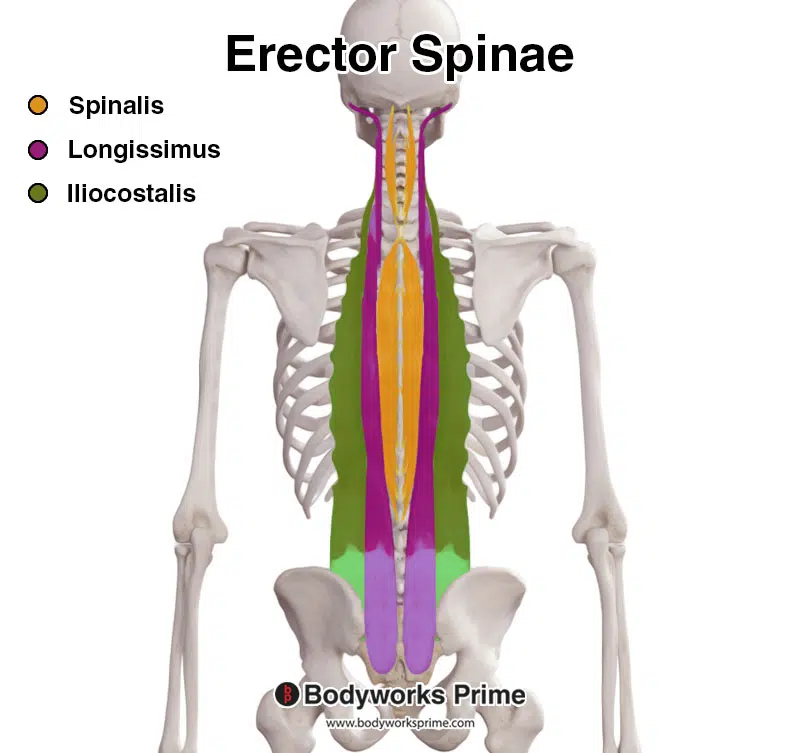
Here we can see each of the erector spinae highlighted in different colours for clarity. The spinalis is highlighted in yellow, the longissimus in purple, and the iliocostalis in green.
[caption align="aligncenter" width="500"]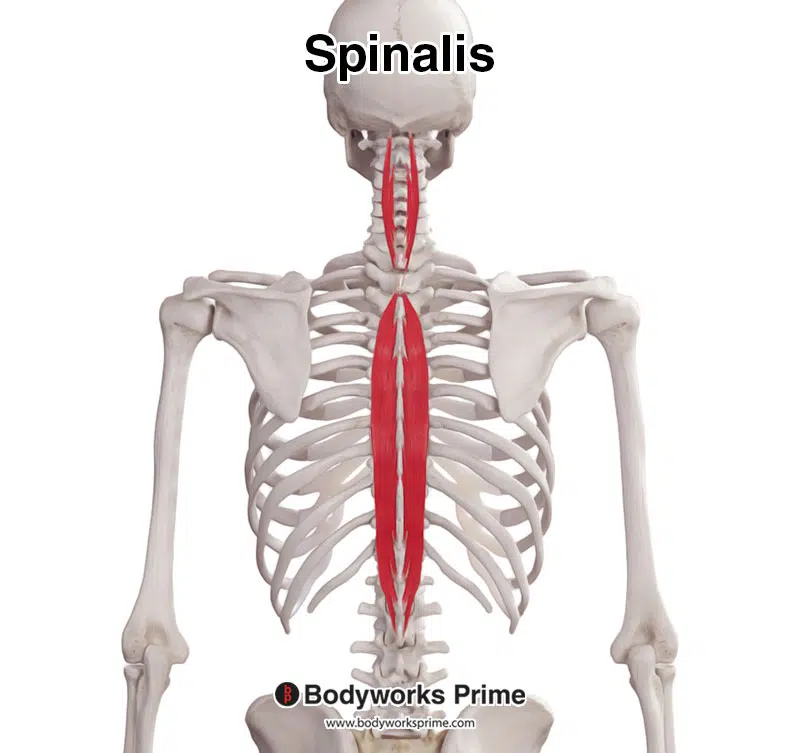
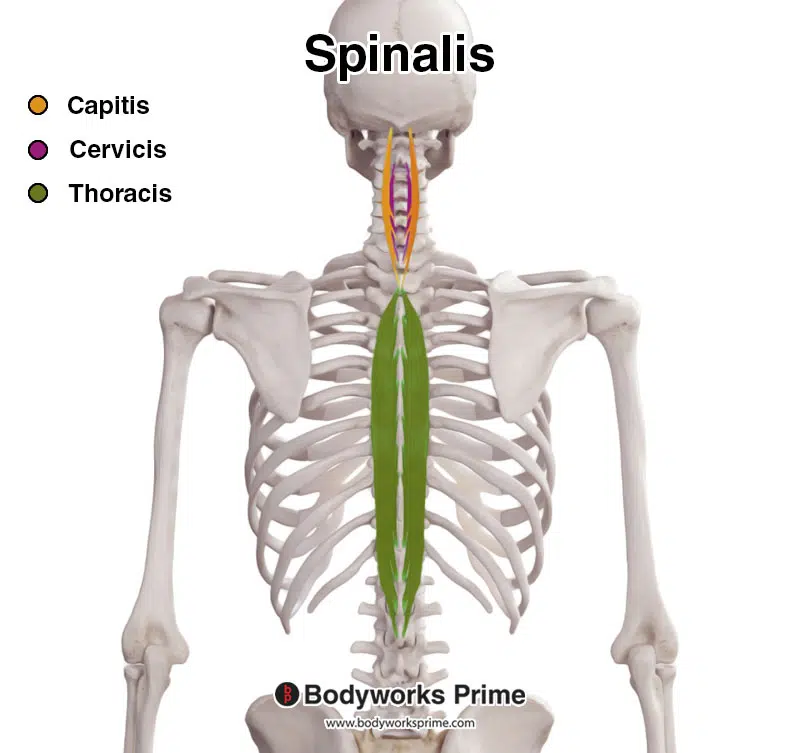
Here we can see the spinalis sections highlighted in different colours. The capitis is highlighted in yellow, the cervicis purple, and thoracis green.

Here we can see the longissimus muscle by itself.
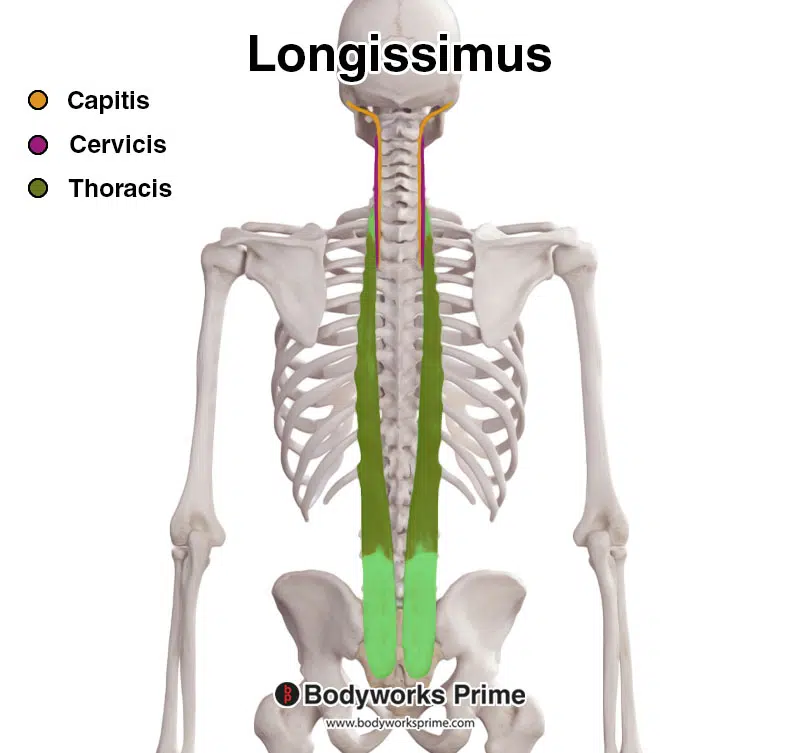
Here we can see the longissimus sections highlighted in different colours. The capitis is highlighted in yellow, the cervicis purple, and thoracis green.
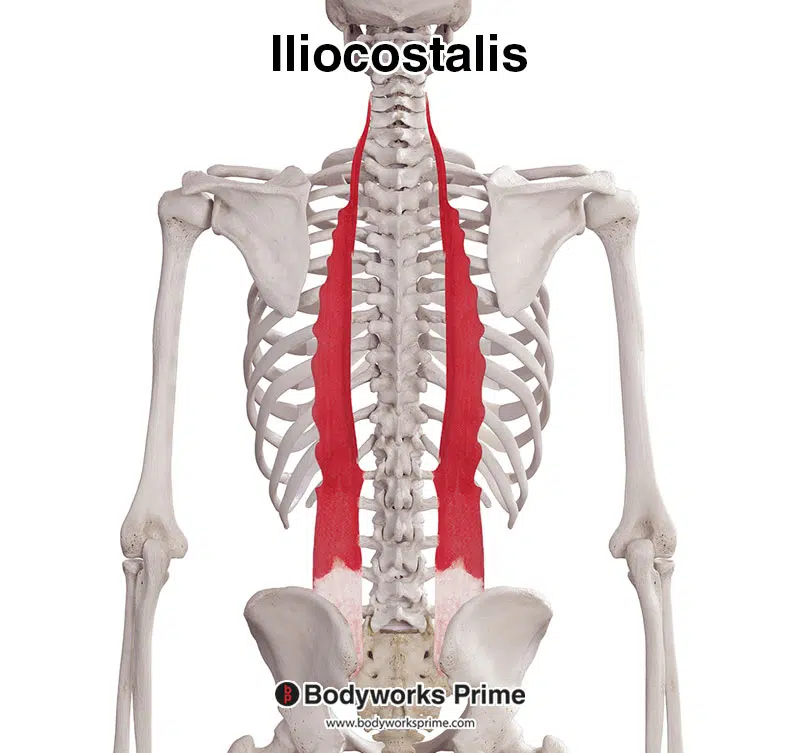
Here we can see the iliocostalis muscle by itself.
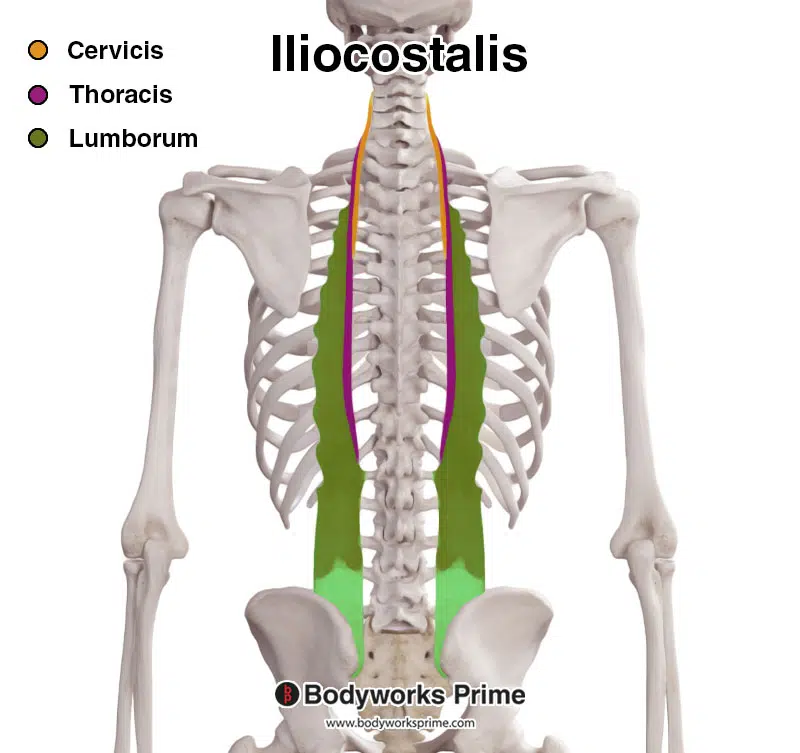
Here we can see the iliocostalis sections highlighted in different colours. The cervicis is highlighted in yellow, the thoracis purple, and the lumborum in green.
Origin & Insertion
The erector spinae muscles each have their own distinct origins and insertions, varying across their respective sections and among individuals. The erector spinae group of muscles includes the spinalis, longissimus, and iliocostalis muscles.
The spinalis muscle, the most medial muscle of the erector spinae, consisting of three distinct sections: spinalis capitis, spinalis cervicis, and spinalis thoracis. The spinalis capitis originates from the spinous processes of C6 to T2 and the associated nuchal ligament and inserts onto the occiput’s medial and inferior aspect[12]. The occiput is a section of bone located at the back of the skull and the nuchal ligament is a ligament on the back of the neck (running from the occiput to C7). The spinalis cervicis begins at the nuchal ligament and the spinous processes of the lower cervical to upper thoracic vertebrae (C7 and T1) and inserts onto the spinous processes of the second or third cervical vertebra (C2 or C3) [13]. Lastly, the spinalis thoracis takes origin on the spinous processes of T11-L2, and inserts onto the spinous processes of the upper thoracic vertebrae T2-T8 [14].
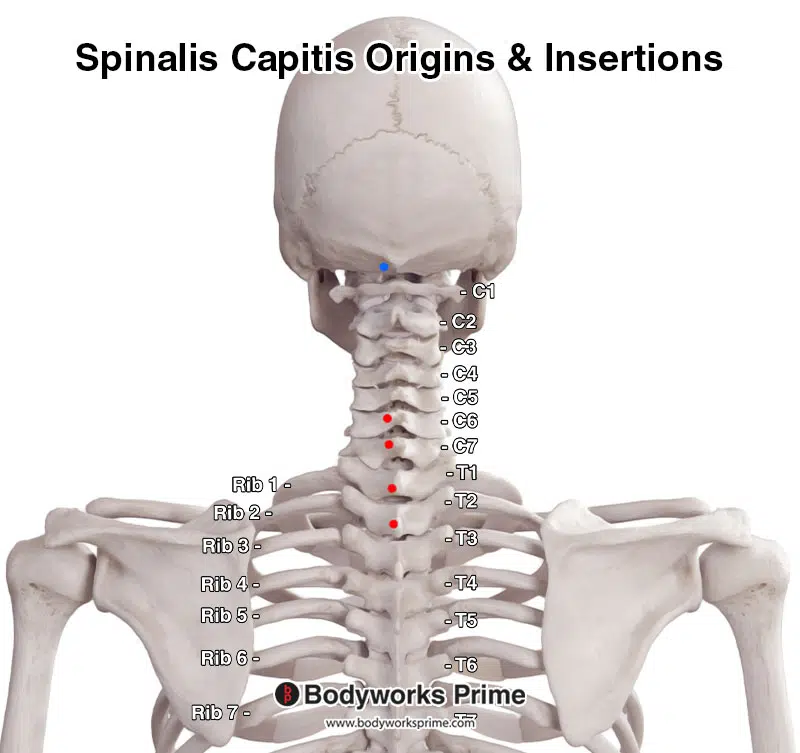
Displayed here are the origin and insertion points of the spinalis capitis muscle (it originates on the spinous processes of C6 to T2 and the associated nuchal ligament and inserts onto the occiput). The muscle’s origins are marked in red, and its insertions are marked in blue.
Note: For the sake of simplicity, only the left side of the muscle is displayed here. However, the origins and insertions are duplicated on the right-hand side as well.
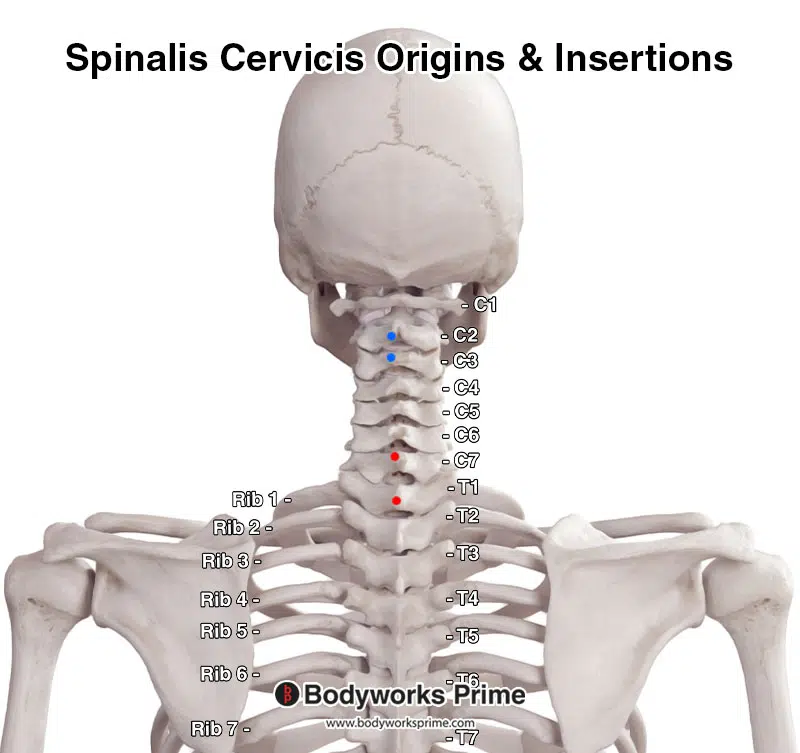
This image shows the origin and insertion sites of the spinalis cervicis section (the origin is the nuchal ligament & spinous processes of C7 and T1 and the insertion is the spinous processes of C2 and C3). The red markings indicate the muscle’s origins, while the blue markings represent its insertions.
Note: For the sake of simplicity, only the left side of the muscle is displayed here. However, the origins and insertions are duplicated on the right-hand side as well.
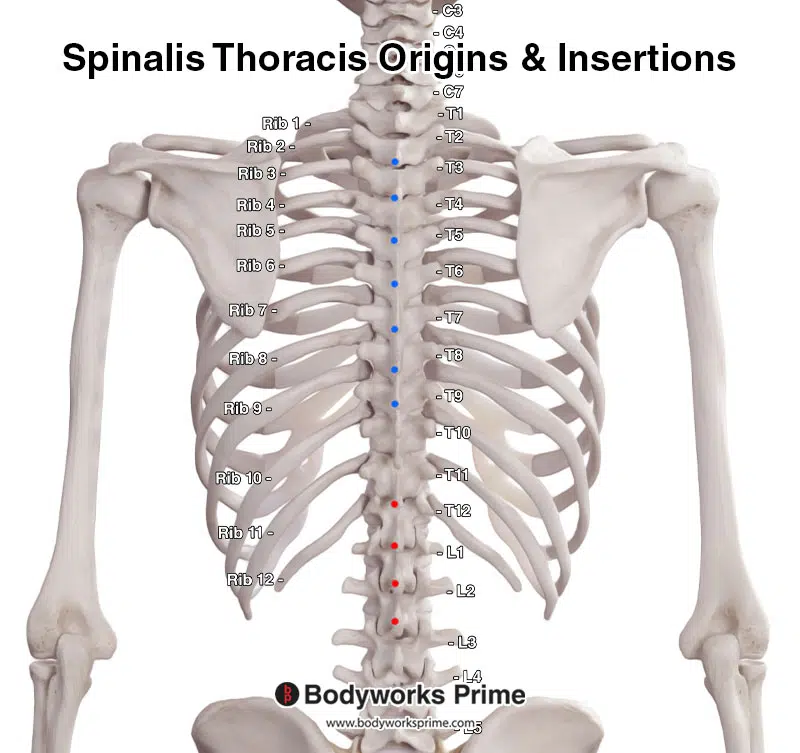
Here we can observe the origin and insertion points of the spinalis thoracis muscle (the origin is the spinous processes of T11-L2 and the insertion is T2-T8). The origins are highlighted in red, while the insertions are colored blue.
Note: For the sake of simplicity, only the left side of the muscle is displayed here. However, the origins and insertions are duplicated on the right-hand side as well.
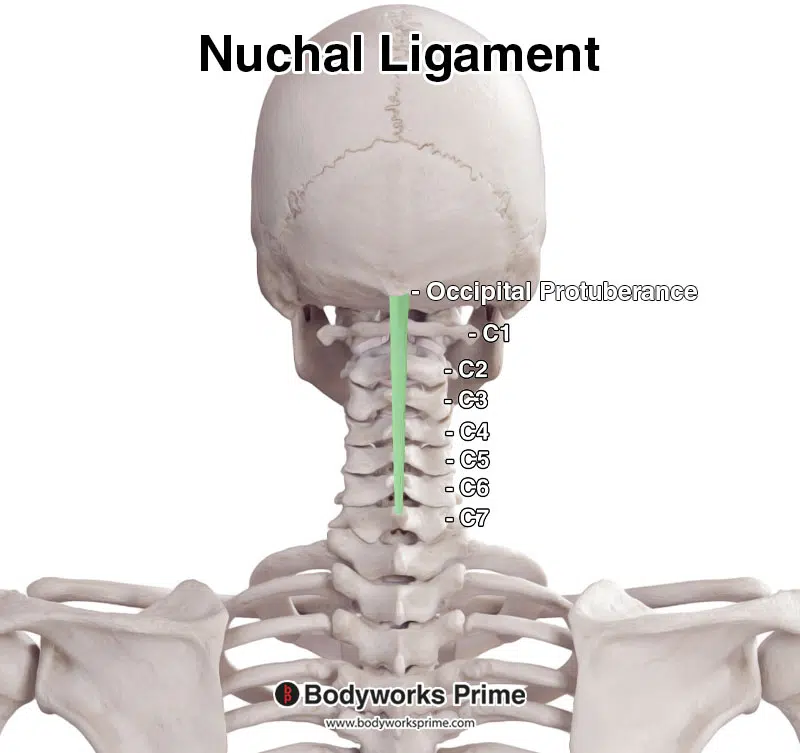
Here we can see the nuchal ligament. The nuchal ligament is also known as the ‘ligamentum nuchae’ in Latin. This ligament is a point of origin for the spinalis cervicis and spinalis capitis sections. The nuchal ligament is located at the back of the neck and extends from the external occipital protuberance to the seventh cervical vertebra.
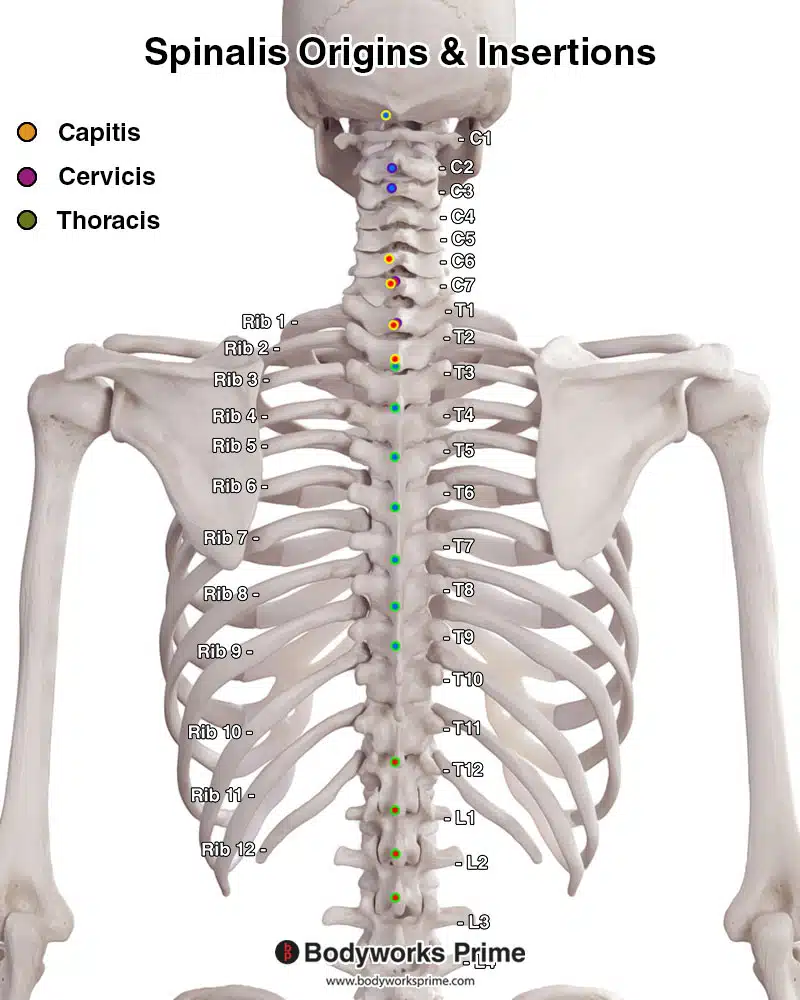
Here we can see all of the spinalis sections’ origins and insertions together. The capitis has a yellow highlight around it, the cervicis has a purple highlight and the thoracis has a green highlight.
The longissimus muscle, the intermediate column of the erector spinae, also has three sections: longissimus capitis, longissimus cervicis, and longissimus thoracis. The longissimus capitis originates from the transverse processes of C4 to T4 vertebrae and inserts at the posterior edge of the mastoid process. The mastoid process is a bony projection on the temporal bone, at the posterior base of the skull. You can feel the bump of the mastoid process on the skull close to the area behind your earlobe. The longissimus cervicis originates from the transverse processes of T1 to T4 vertebrae and inserts at the posterior tubercle of C2 to C6 transverse processes [15]. The longissimus thoracis originates from the dorsal surface of the sacrum and its median sacral crest, the medial surface of the posterior superior iliac spine, and the transverse processes of L1 to L5 vertebrae. The insertion is on the transverse processes of T1 to T12 vertebrae and the dorsal aspect of ribs 3 to 12, between the rib angle and tubercle [16].
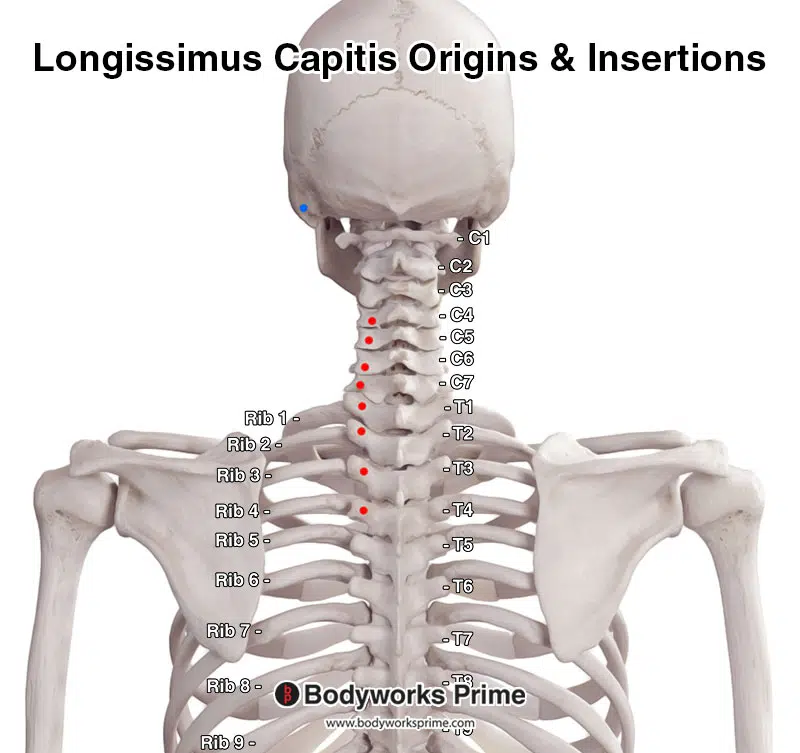
This image shows the points of origin and insertion of the longissimus capitis segment (the origin is on the transverse processes of C4 to T4 vertebrae and it inserts at the posterior edge of the mastoid process). The origin points are marked in red and the insertion points highlighted in blue.
Note: For the sake of simplicity, only the left side of the muscle is displayed here. However, the origins and insertions are duplicated on the right-hand side as well.

The points of origin and insertion of the longissimus cervicis are displayed in this picture (the origin is on the transverse processes of T1 to T4 and it inserts on the transverse processes of C2 to C6). The origin points are marked in red and the insertion points marked in blue.
Note: For the sake of simplicity, only the left side of the muscle is displayed here. However, the origins and insertions are duplicated on the right-hand side as well.

In this picture are the origins and insertions of the longissimus thoracis section (it originates on the dorsal surface of the sacrum and its median sacral crest, the medial surface of the posterior superior iliac spine, and the transverse processes of L1 to L5 vertebrae. It inserts at the transverse processes of T1 to T12 vertebrae and the dorsal aspect of ribs 3 to 12, between the rib angle and tubercle. The origins are highlighted in red and the insertions are highlighted in blue.
Note: For the sake of simplicity, only the left side of the muscle is displayed here. However, the origins and insertions are duplicated on the right-hand side as well.
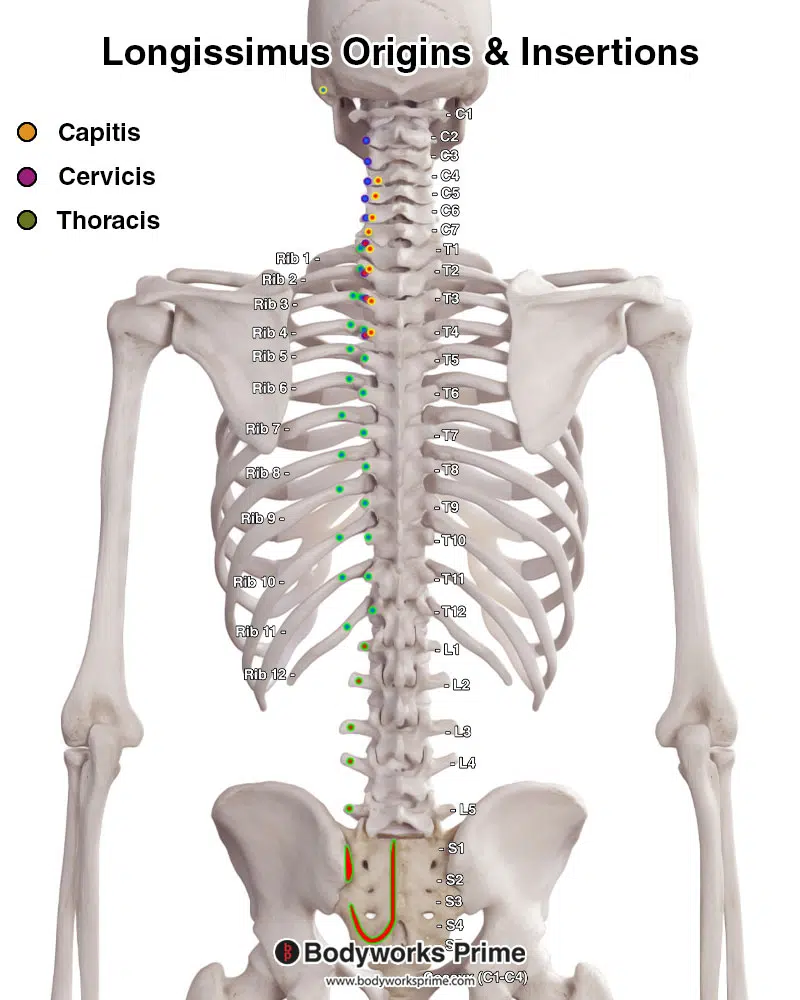
Here we can see all of the longissimus’ sections’ origins and insertions together. The capitis has a yellow highlight around it, the cervicis has a purple highlight and the thoracis has a green highlight.
The iliocostalis muscle, the lateral column of the erector spinae, includes the iliocostalis cervicis, iliocostalis thoracis, and iliocostalis lumborum. The iliocostalis cervicis has its origin at the angles of ribs 3 to 6 and inserts at the posterior tubercle of the transverse process of vertebrae C4 to C6. The iliocostalis thoracis originates at the angles of the bottom six ribs and inserts at the transverse process of vertebra C7 and the angles of the top six ribs [17]. The iliocostalis lumborum originates at the medial end and dorsal segment of the iliac crest and the lateral crest of the sacrum, inserting at the lumbar transverse processes of L1 to L4, the angles of ribs 4 to 12, and the thoracolumbar fascia. The thoracolumbar fascia is a large, diamond-shaped connective tissue structure located in the lower back, spanning from the lower thoracic to the upper lumbar spine. It encases the muscles of the lower back [18].

Displayed in this picture are the origins and insertions of the iliocostalis cervicis section (the origin is on the angles of ribs 3 to 6 and it inserts on the transverse process of C4 to C6). The origins are highlighted in red and insertions are highlighted in blue.
Note: For the sake of simplicity, only the left side of the muscle is displayed here. However, the origins and insertions are duplicated on the right-hand side as well.
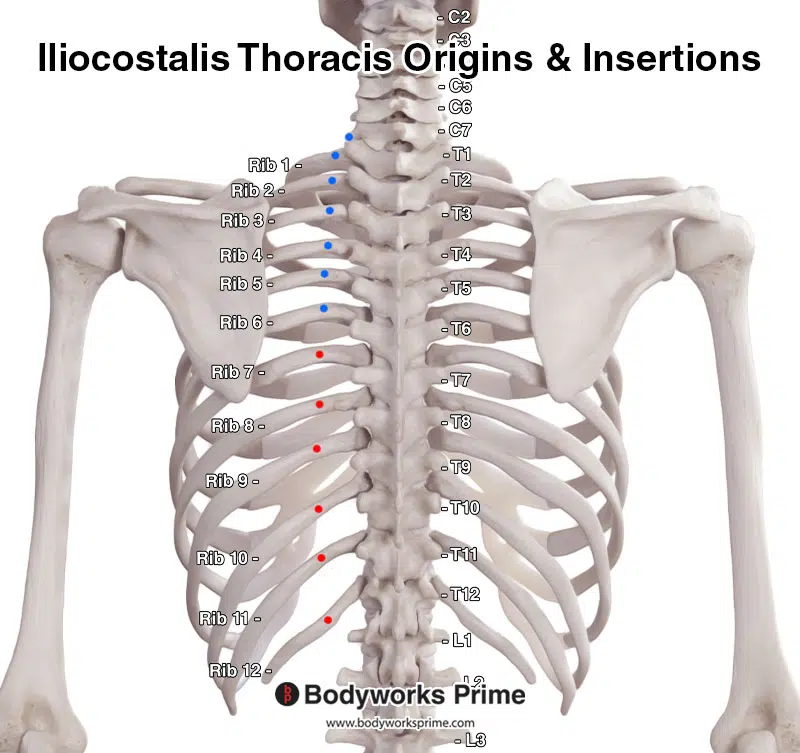
This image displays the origins and insertions of the iliocostalis thoracis section (the origin is the angles of the bottom six ribs and it inserts on the transverse process of C7 and the angles of the top six ribs). The origins are highlighted in red and the insertions are highlighted in blue.
Note: For the sake of simplicity, only the left side of the muscle is displayed here. However, the origins and insertions are duplicated on the right-hand side as well.

This image shows the origins and insertions of the iliocostalis lumborum section (the origin is on the medial end and dorsal segment of the iliac crest and the lateral crest of the sacrum. It inserts onto the lumbar transverse processes of L1 to L4, the angles of ribs 4 to 12, and the thoracolumbar fascia). The origins highlighted in red and the insertions in blue.
Note: For the sake of simplicity, only the left side of the muscle is displayed here. However, the origins and insertions are duplicated on the right-hand side as well.
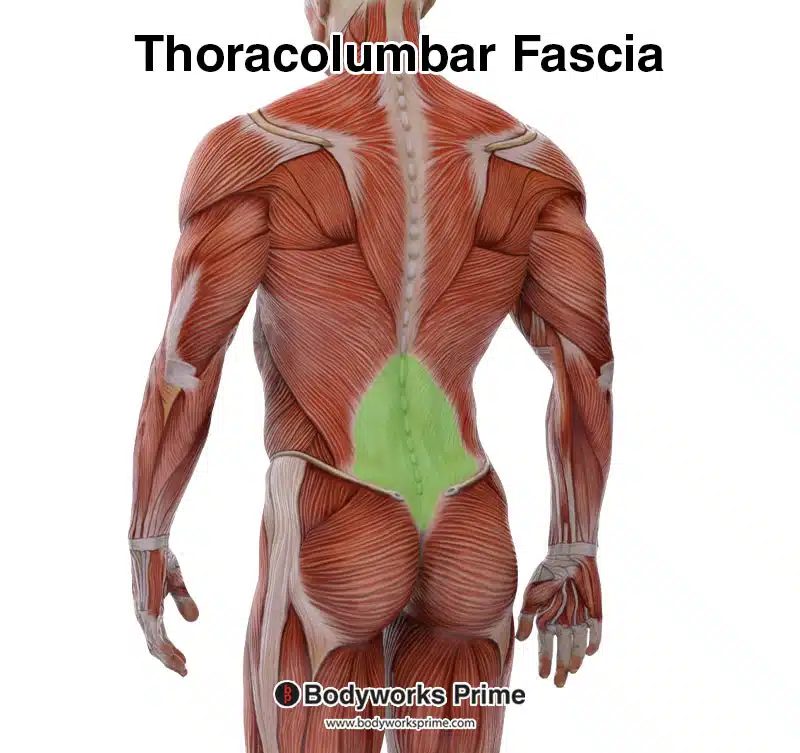
Highlighted in green we can see the thoracolumbar fascia, an insertion point of the iliocostalis lumborum section. The thoracolumbar fascia is a large, diamond-shaped complex of connective tissue, situated in the lower back region.
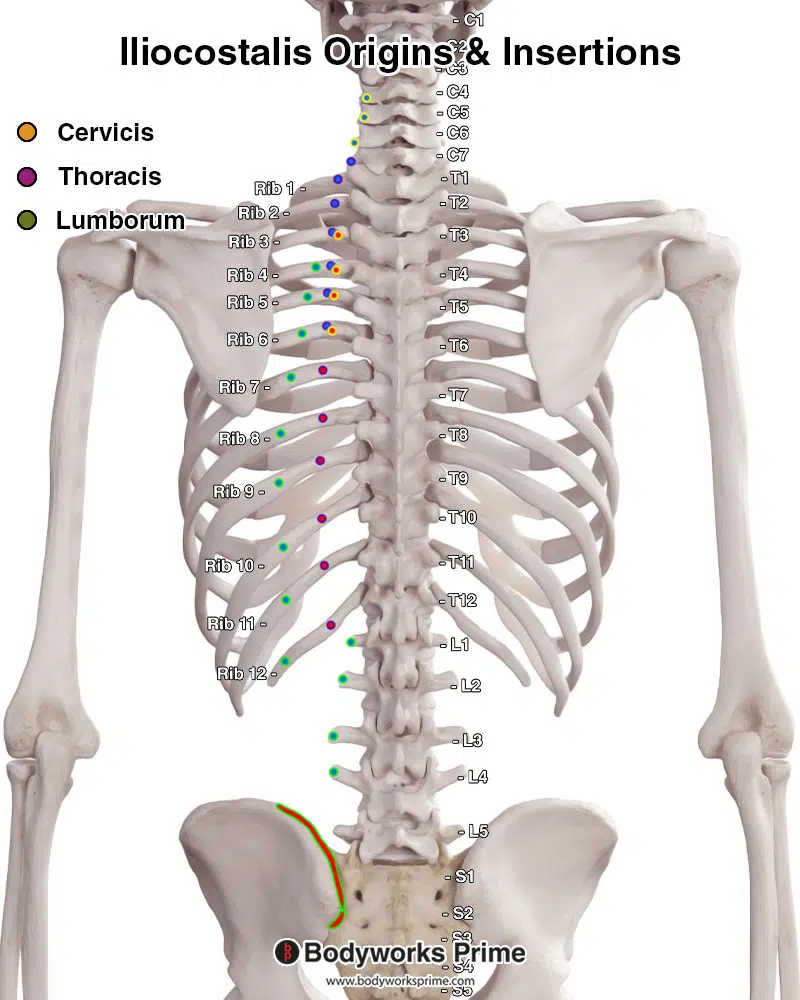
Here we can see all of the iliocostalis’ sections’ origins and insertions together. The cervicis has a yellow highlight around it, the thoracis has a purple highlight and the lumborum has a green highlight.
Actions
The erector spinae, consisting of the spinalis, longissimus, and iliocostalis muscles, plays an important role in various actions of the spine, neck, and trunk. The effects of these muscles are contingent on whether unilateral or bilateral contractions occur, with unilateral referring to a single side contracting and bilateral involving simultaneous contractions on both sides [19] [20] [21].
The spinalis muscle, divided into thoracis, cervicis, and capitis sections, each influences its corresponding vertebral region. For the thoracis segment, unilateral contraction results in lateral flexion of the trunk, while bilateral contraction leads to trunk extension [22] [23]. The cervicis and capitis sections of the spinalis primarily affect the neck’s movement, with bilateral contractions extending the neck, and unilateral contractions causing ipsilateral lateral flexion [24] [25].
The longissimus muscle, with its capitis, cervicis, and thoracis segments also influences both trunk and neck movements. Bilateral contractions lead to the extension of the trunk and neck, whereas unilateral contractions result in lateral flexion. The longissimus capitis affects movements of the neck and upper thoracic vertebrae, whereas the longissimus thoracis influences trunk movements [26] [27] [28].
The iliocostalis muscle with its cervicis, thoracis, and lumborum sections contributes to the movements of the trunk and vertebral column, with unilateral contractions causing lateral flexion and bilateral contractions leading to extension. The cervicis segment of the iliocostalis also provides weak support for lateral flexion at the neck’s base during unilateral contractions and weak extension at the neck’s base during bilateral contractions [29] [30] [31].
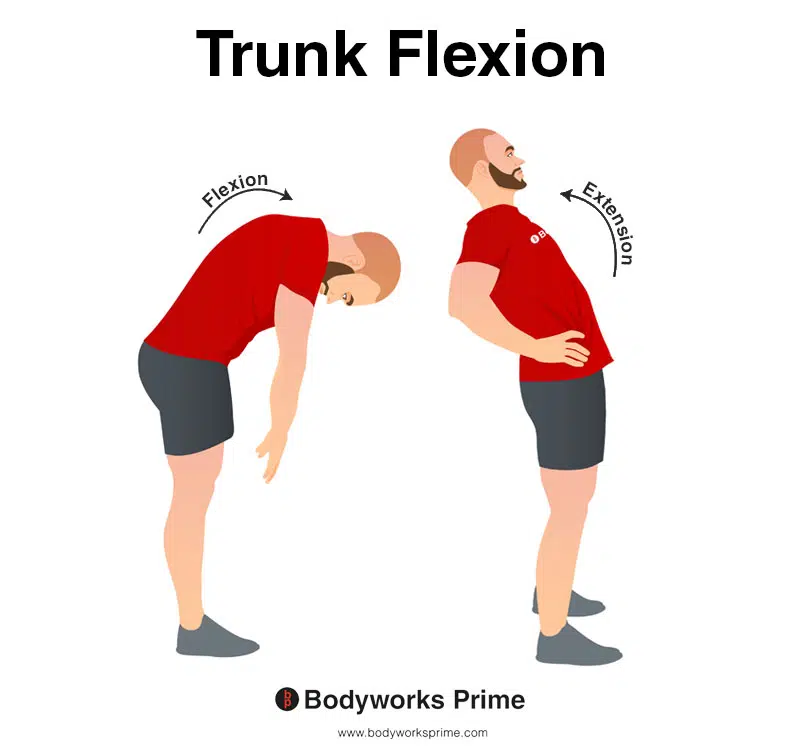
This image shows an example of trunk flexion, which involves bending the torso forwards. The opposite of trunk flexion is trunk extension. Bilateral contraction will result in this action. However, bear in mind, only the parts of the erector spinae that cross the trunk will be able to flex it.
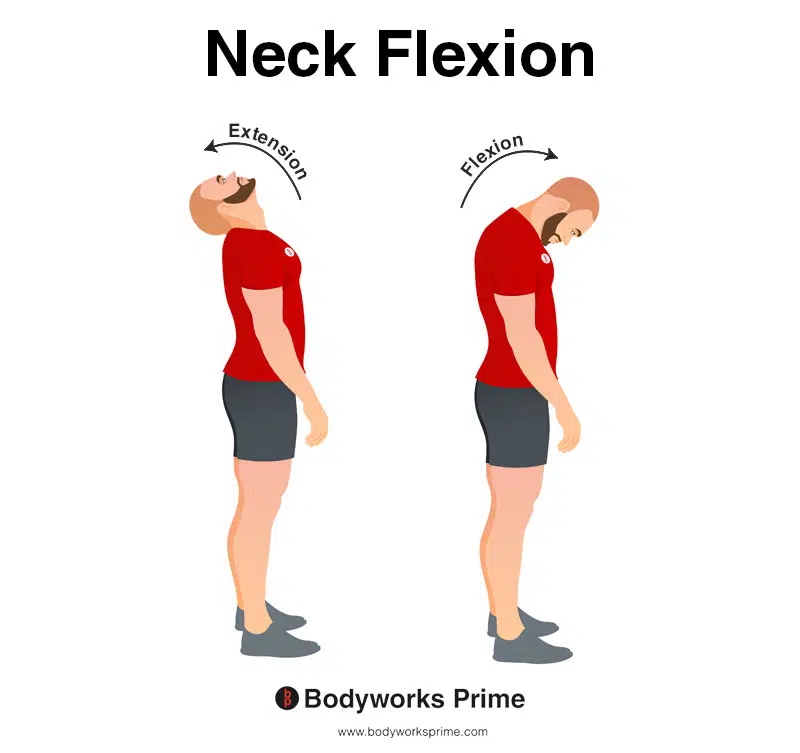
This image demonstrates neck flexion, which involves bending the neck forwards. The opposite of neck flexion is neck extension. Bilateral contraction will result in this action. However, bear in mind, only the parts of the erector spinae that cross the neck will be able to flex it.

This image demonstrates trunk lateral flexion, which involves bending the torso to the side. Unilateral contraction will result in lateral flexion. However, bear in mind, only the parts of the erector spinae that cross the trunk will be able to laterally flex it.
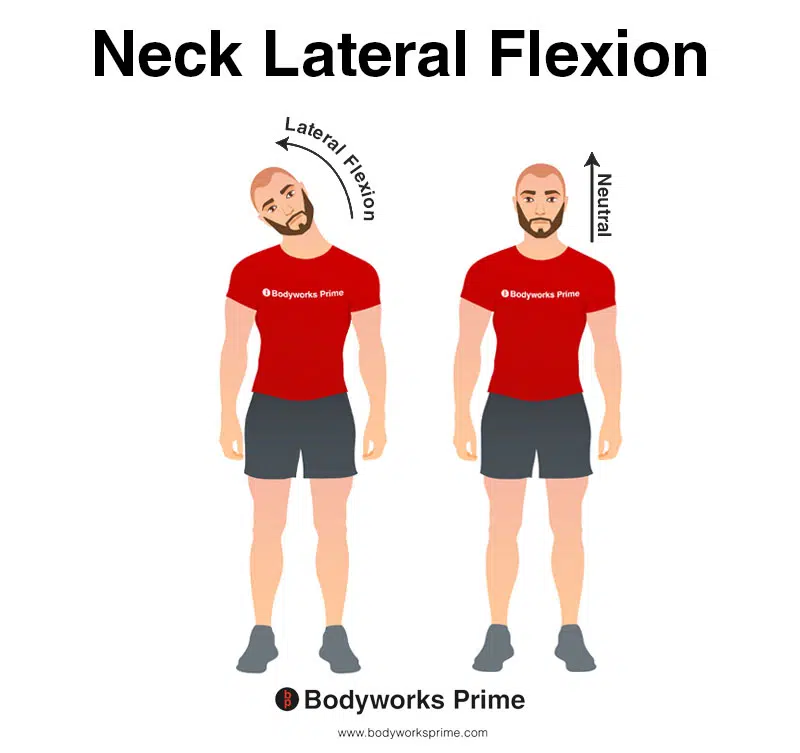
This image demonstrates neck lateral flexion, which involves bending the neck to the side. Unilateral contraction will result in this action. However, bear in mind, only the parts of the erector spinae that cross the neck will be able to laterally flex it.
Innervation
The erector spinae group of muscles receive their innervation through the lateral branches of the posterior rami of the spinal nerves, with the specificity of nerve supply corresponding to the different sections of each muscle [32][33][34].
The spinalis muscle receives innervation in its thoracic portion from the posterior rami of the thoracic and upper lumbar nerves. Its cervicis and capitis segments are innervated by the posterior rami of the cervical and upper thoracic nerves [35][36].
Similarly, the longissimus muscle gets its innervation from the corresponding lateral branches of the spinal nerves. The cervical, thoracic, and lumbar portions of the longissimus muscle are each innervated by the lateral branches of the corresponding spinal nerves’ posterior rami [37][38][39].
The iliocostalis muscle is innervated by the lateral branches of the posterior rami of the spinal nerves, with each vertebral level catering to its own nerve supply [40][41][42].

Pictured here is a cross-section of a lumbar vertebra. One of the labeled parts is the ‘dorsal ramus’, which is also known as the ‘posterior ramus’. Each segment of the erector spinae muscles receives innervation from the posterior ramus of the corresponding spinal nerve. In other words, the part of the muscle aligned with a specific spinal segment is innervated by that specific spinal nerve’s posterior ramus.
Blood Supply
The spinalis muscle obtains its blood supply from the dorsal branches of the posterior intercostal artery, the deep cervical artery, and the muscular branches of the vertebral artery [43][44][45].
The longissimus muscle gets its blood supply from the vertebral artery, deep cervical artery, occipital artery, and transverse cervical artery for the capitis and cervicis parts. The thoracis segment of the longissimus muscle receives blood from the superior intercostal artery, posterior intercostal artery, subcostal artery, lateral sacral artery, and median sacral artery [46][47][48].
The iliocostalis muscle gets its blood supply from the dorsal branches of the posterior intercostal, subcostal, lumbar, and lateral sacral arteries [49][50][51].
Want some flashcards to help you remember this information? Then click the link below:
Spinalis Flashcards
Longissimus Flashcards
Iliocostalis Flashcards
Support Bodyworks Prime
Running a website and YouTube channel can be expensive. Your donation helps support the creation of more content for my website and YouTube channel. All donation proceeds go towards covering expenses only. Every contribution, big or small, makes a difference!
References
| ↑1, ↑19, ↑22, ↑24, ↑26, ↑29 | Standring S. (2015). Gray’s Anatomy: The Anatomical Basis of Clinical Practice, 41st Edn. Amsterdam: Elsevier. |
|---|---|
| ↑2, ↑5, ↑8, ↑9, ↑14, ↑15, ↑17, ↑21, ↑23, ↑28, ↑30, ↑35, ↑39, ↑40, ↑43, ↑48, ↑49 | Henson B, Kadiyala B, Edens MA. Anatomy, Back, Muscles. [Updated 2022 Aug 25]. In: StatPearls [Internet]. Treasure Island (FL): StatPearls Publishing; 2022 Jan-. Available from: https://www.ncbi.nlm.nih.gov/books/NBK537074/ |
| ↑3, ↑12, ↑13, ↑36, ↑44 | Greiner TM, Bedford ME, Walker RA. Variability in the human m. spinalis capitis and cervicis: frequencies and definitions. Ann Anat. 2004 Apr;186(2):185-91. doi: 10.1016/S0940-9602(04)80039-6. PMID: 15125051. |
| ↑4, ↑7, ↑10, ↑16, ↑18, ↑20, ↑25, ↑32, ↑37, ↑41, ↑45, ↑47, ↑50 | Moore KL, Agur AMR, Dalley AF. Clinically Oriented Anatomy. 8th ed. Philadelphia: Lippincot Williams & Wilkins; 2017. |
| ↑6, ↑27, ↑33, ↑38, ↑46 | Cramer, G. D., & Darby, S. A. (2014). Clinical anatomy of the spine, spinal cord, and ANS (3rd ed.). St. Louis: Elsevier. ISBN 9780323079549. |
| ↑11, ↑31, ↑34, ↑42, ↑51 | Chaitow, Leon, and DeLany, Judith (2011), Clinical Application of Neuromuscular Techniques, Volume 2 (Second Edition), Oxford: Churchill Livingstone, ISBN 978-0-443-06815-7 |










